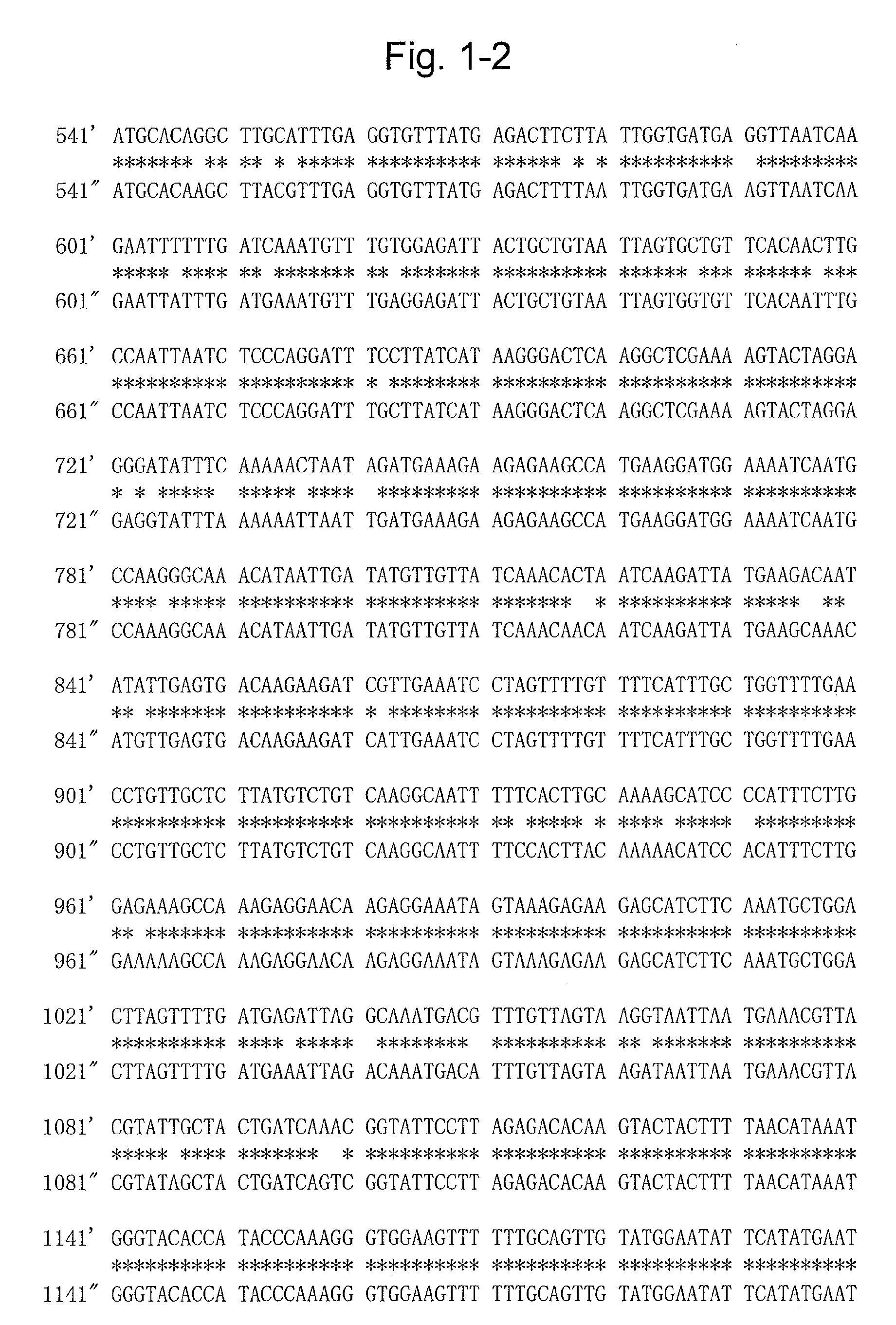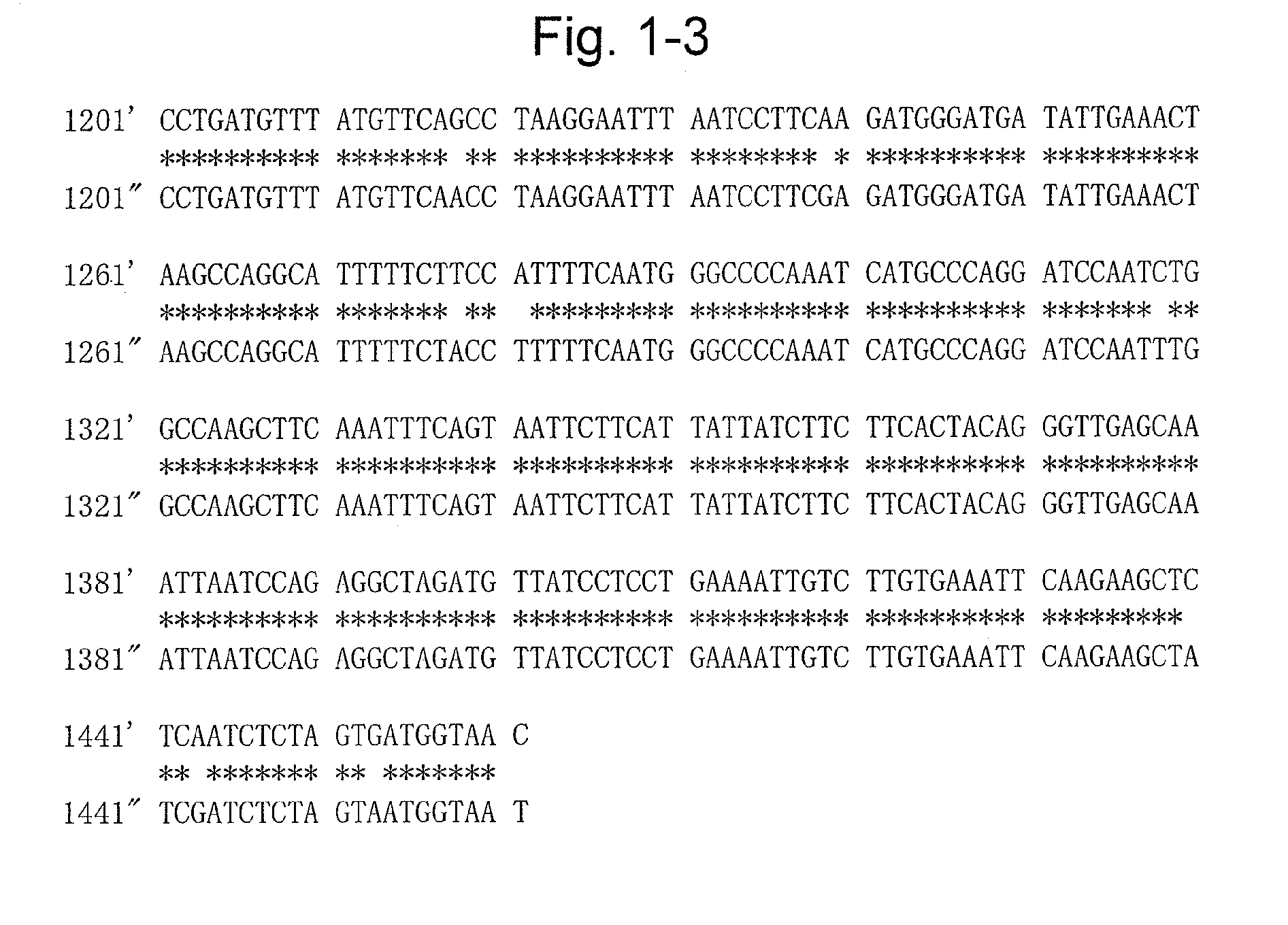Protein having glycoalkaloid biosynthetic enzyme activity and gene encoding the same
a glycoalkaloid and biosynthetic enzyme technology, applied in the field of proteins having glycoalkaloid biosynthetic enzyme activity and gene encoding the same, can solve the problems of mild disturbance of consciousness, poisoning symptoms, vertigo, etc., and achieve the effect of low cos
- Summary
- Abstract
- Description
- Claims
- Application Information
AI Technical Summary
Benefits of technology
Problems solved by technology
Method used
Image
Examples
example 1
Acquisition of the Full-Length Sequence of the Candidate Glycoalkaloid Biosynthetic Gene E
[0088]Extraction of mRNA from the sprouts of a variety of potato (Solanum tuberosum), “Sassy”, was carried out using RNeasy (QIAGEN). Total cDNA synthesis was carried out using a SuperScript First-Strand System (Invitrogen). While the aglycone of a glycoalkaloid is presumed to be formed from cholesterol, this has not been verified (Non-Patent Literature 1). However, even assuming that the aglycone is formed from a cholesterol-related compound, there must be some hydroxylation steps. In the steps of hydroxylation, the possible involvement of at least three types of enzymes, namely cytochrome P450 monooxygenase, dioxygenase, and NADPH-flavin reductase, is considered. Of these, cytochrome P450 monooxygenase was designated as a target, and as a gene expressed in potatoes, the TC155233 gene, for which many EST clones have been isolated from the sprouts, was focused based on the information published...
example 2
Isolation of the Genomic Gene of the Candidate Glycoalkaloid Biosynthetic Gene E
[0091]Genomic DNA was extracted from “Sassy” using RNeasy (QIAGEN). PCR was performed using the same primers as those used in Example 1 and (U904: TGATAAGGAAATCCTGGGAGA (SEQ ID NO: 8) and U901: AGAGAAGCCATGAAGGATGG (SEQ ID NO: 9)), and further, for the second intron, using PrimeSTAR HS DNA Polymerase (TAKARA BIO INC.) as the enzyme and (U898: GAAATACGCTACTACGGAAGAACC (SEQ ID NO: 10) and U899: CGTCATTTGCCTAATCTCATC (SEQ ID NO: 11)) as the primers, whereby the full-length genomic DNA was sequenced (SEQ ID NO: 5). It was revealed that there were seven introns. (Example 3) Vector construction for the production of a transformant in which the candidate glycoalkaloid biosynthetic gene E is suppressed
[0092]As to the method for suppressing the above gene by transformation, a reverse complementary gene fragment configured to be driven by a strong promoter was expressed (which is generally referred to as the RNAi ...
example 4
Production of a Transformed Potato Plant
[0093]The vector prepared in Example 3 was introduced into the Agrobacterium tumefaciens GV3110 strain by the electroporation method (Gelvin and Schilperoor, Plant Molecular Biology Manual, C2, 1 to 32 (1994), Kluwer Academic Publishers). The Agrobacterium tumefaciens GV3110 strain containing the vector was subjected to shaking culture at 28° C. for 12 hours in a YEB liquid medium (5 g / l beef extract, 1 g / l yeast extract, 5 g / l peptone, 5 g / l sucrose, and 2 mM magnesium sulfate (pH 7.2)) containing 50 ppm kanamycin. The resulting culture solution (1.5 ml) was centrifuged at 10,000 rpm for three minutes to collect the bacteria, which were washed with 1 ml of an LB medium for removal of kanamycin. Further, centrifugation was performed at 10,000 rpm for three minutes to collect the bacteria, which were resuspended in 1.5 ml of an MS medium containing 3% sucrose (Murashige and Skoog, Physiol. Plant., 15, 473 to 497 (1962)), and the resulting solut...
PUM
| Property | Measurement | Unit |
|---|---|---|
| pH | aaaaa | aaaaa |
| thickness | aaaaa | aaaaa |
| weight | aaaaa | aaaaa |
Abstract
Description
Claims
Application Information
 Login to View More
Login to View More - R&D
- Intellectual Property
- Life Sciences
- Materials
- Tech Scout
- Unparalleled Data Quality
- Higher Quality Content
- 60% Fewer Hallucinations
Browse by: Latest US Patents, China's latest patents, Technical Efficacy Thesaurus, Application Domain, Technology Topic, Popular Technical Reports.
© 2025 PatSnap. All rights reserved.Legal|Privacy policy|Modern Slavery Act Transparency Statement|Sitemap|About US| Contact US: help@patsnap.com



